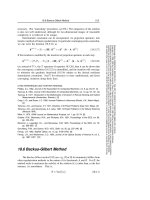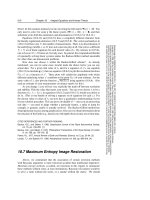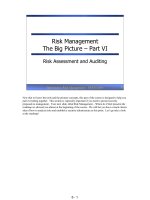Tài liệu Integral Equations and Inverse Theory part 3 ppt
Bạn đang xem bản rút gọn của tài liệu. Xem và tải ngay bản đầy đủ của tài liệu tại đây (153.8 KB, 4 trang )
794
Chapter 18. Integral Equations and Inverse Theory
Sample page from NUMERICAL RECIPES IN C: THE ART OF SCIENTIFIC COMPUTING (ISBN 0-521-43108-5)
Copyright (C) 1988-1992 by Cambridge University Press.Programs Copyright (C) 1988-1992 by Numerical Recipes Software.
Permission is granted for internet users to make one paper copy for their own personal use. Further reproduction, or any copying of machine-
readable files (including this one) to any servercomputer, is strictly prohibited. To order Numerical Recipes books,diskettes, or CDROMs
visit website or call 1-800-872-7423 (North America only),or send email to (outside North America).
is symmetric. However, since the weights w
j
are not equal for most quadrature
rules, the matrix
K (equation 18.1.5) is not symmetric. The matrix eigenvalue
problem is much easier for symmetric matrices, and so we should restore the
symmetry if possible. Provided the weightsare positive(which they are for Gaussian
quadrature), we can define the diagonal matrix D = diag(w
j
) and its square root,
D
1/2
= diag(
√
w
j
). Then equation (18.1.7) becomes
K · D · f = σf
Multiplying by D
1/2
,weget
D
1/2
·K·D
1/2
·h=σh (18.1.8)
where h = D
1/2
·f. Equation (18.1.8) is now in the form of a symmetric eigenvalue
problem.
Solution of equations (18.1.7) or (18.1.8) will in general give N eigenvalues,
where N is the number of quadrature points used. For square-integrable kernels,
these will provide good approximations to the lowest N eigenvalues of the integral
equation. Kernels of finite rank (also called degenerate or separable kernels) have
only a finite number of nonzero eigenvalues (possibly none). You can diagnose
this situation by a cluster of eigenvalues σ that are zero to machine precision. The
number of nonzero eigenvalues will stay constant as you increase N to improve
their accuracy. Some care is required here: A nondegenerate kernel can have an
infinite number of eigenvalues that have an accumulation point at σ =0.You
distinguish the two cases by the behavior of the solution as you increase N. If you
suspect a degenerate kernel, you will usually be able to solve the problem by analytic
techniques described in all the textbooks.
CITED REFERENCES AND FURTHER READING:
Delves, L.M., and Mohamed, J.L. 1985,
Computational Methods for Integral Equations
(Cam-
bridge, U.K.: Cambridge University Press). [1]
Atkinson, K.E. 1976,
A Survey of Numerical Methods for the Solution of Fredholm Integral
Equations of the Second Kind
(Philadelphia: S.I.A.M.).
18.2 Volterra Equations
Let us now turn to Volterra equations, of which our prototype is the Volterra
equation of the second kind,
f(t)=
t
a
K(t, s)f(s) ds + g(t)(18.2.1)
Most algorithmsforVolterraequationsmarch outfromt = a, buildingup thesolution
as they go. In this sense they resemble not only forward substitution (as discussed
18.2 Volterra Equations
795
Sample page from NUMERICAL RECIPES IN C: THE ART OF SCIENTIFIC COMPUTING (ISBN 0-521-43108-5)
Copyright (C) 1988-1992 by Cambridge University Press.Programs Copyright (C) 1988-1992 by Numerical Recipes Software.
Permission is granted for internet users to make one paper copy for their own personal use. Further reproduction, or any copying of machine-
readable files (including this one) to any servercomputer, is strictly prohibited. To order Numerical Recipes books,diskettes, or CDROMs
visit website or call 1-800-872-7423 (North America only),or send email to (outside North America).
in §18.0), but also initial-value problems for ordinary differential equations. In fact,
many algorithms for ODEs have counterparts for Volterra equations.
The simplest way to proceed is to solve the equation on a mesh with uniform
spacing:
t
i
= a + ih, i =0,1, ,N, h≡
b−a
N
(18.2.2)
To do so, we must choose a quadrature rule. For a uniform mesh, the simplest
scheme is the trapezoidal rule, equation (4.1.11):
t
i
a
K(t
i
,s)f(s)ds = h
1
2
K
i0
f
0
+
i−1
j=1
K
ij
f
j
+
1
2
K
ii
f
i
(18.2.3)
Thus the trapezoidal method for equation (18.2.1) is:
f
0
= g
0
(1 −
1
2
hK
ii
)f
i
= h
1
2
K
i0
f
0
+
i−1
j=1
K
ij
f
j
+ g
i
,i=1, ,N
(18.2.4)
(For a Volterra equation of the first kind, the leading 1 on the left would be absent,
and g would have opposite sign, with corresponding straightforward changes in the
rest of the discussion.)
Equation (18.2.4) is an explicit prescription that gives the solution in O(N
2
)
operations. UnlikeFredholm equations,it is not necessary to solve a system of linear
equations. Volterra equations thus usually involve less work than the corresponding
Fredholm equations which, as we have seen, do involve the inversion of, sometimes
large, linear systems.
The efficiency of solving Volterra equations is somewhat counterbalanced by
the fact that systems of these equations occur more frequently in practice. If we
interpret equation (18.2.1) as a vector equation for the vector of m functions f(t),
then the kernel K(t, s) is an m × m matrix. Equation (18.2.4) must now also be
understood as a vector equation. For each i,wehavetosolvethem×mset of
linear algebraic equations by Gaussian elimination.
The routine voltra below implements this algorithm. You must supply an
external function that returns the kth function of the vector g(t) at the point t,and
another that returns the (k, l) element of the matrix K(t, s) at (t, s). The routine
voltra then returns the vector f(t) at the regularly spaced points t
i
.
#include "nrutil.h"
void voltra(int n, int m, float t0, float h, float *t, float **f,
float (*g)(int, float), float (*ak)(int, int, float, float))
Solves a set of
m linear Volterra equations of the second kind using the extended trapezoidal rule.
On input,
t0 is the starting point of the integration and n-1 is the number of steps of size h to
be taken.
g(k,t) is a user-supplied external function that returns g
k
(t), while ak(k,l,t,s)
is another user-supplied external function that returns the (k, l) element of the matrix K(t, s).
The solution is returned in
f[1 m][1 n], with the corresponding abscissas in t[1 n].
{
796
Chapter 18. Integral Equations and Inverse Theory
Sample page from NUMERICAL RECIPES IN C: THE ART OF SCIENTIFIC COMPUTING (ISBN 0-521-43108-5)
Copyright (C) 1988-1992 by Cambridge University Press.Programs Copyright (C) 1988-1992 by Numerical Recipes Software.
Permission is granted for internet users to make one paper copy for their own personal use. Further reproduction, or any copying of machine-
readable files (including this one) to any servercomputer, is strictly prohibited. To order Numerical Recipes books,diskettes, or CDROMs
visit website or call 1-800-872-7423 (North America only),or send email to (outside North America).
void lubksb(float **a, int n, int *indx, float b[]);
void ludcmp(float **a, int n, int *indx, float *d);
int i,j,k,l,*indx;
float d,sum,**a,*b;
indx=ivector(1,m);
a=matrix(1,m,1,m);
b=vector(1,m);
t[1]=t0;
for (k=1;k<=m;k++) f[k][1]=(*g)(k,t[1]); Initialize.
for (i=2;i<=n;i++) { Take a st ep h.
t[i]=t[i-1]+h;
for (k=1;k<=m;k++) {
sum=(*g)(k,t[i]); Accumulate right-hand side of linear
equations in sum.for (l=1;l<=m;l++) {
sum += 0.5*h*(*ak)(k,l,t[i],t[1])*f[l][1];
for (j=2;j<i;j++)
sum += h*(*ak)(k,l,t[i],t[j])*f[l][j];
a[k][l]=(k == l)-0.5*h*(*ak)(k,l,t[i],t[i]); Left-hand side goes
in matrix a.}
b[k]=sum;
}
ludcmp(a,m,indx,&d); Solve linear equations.
lubksb(a,m,indx,b);
for (k=1;k<=m;k++) f[k][i]=b[k];
}
free_vector(b,1,m);
free_matrix(a,1,m,1,m);
free_ivector(indx,1,m);
}
For nonlinearVolterraequations,equation(18.2.4) holds with theproduct K
ii
f
i
replaced by K
ii
(f
i
), and similarly for the other two products of K’s and f’s. Thus
for each i we solve a nonlinear equation for f
i
with a known right-hand side.
Newton’s method (§9.4 or §9.6) with an initial guess of f
i−1
usually works very
well provided the stepsize is not too big.
Higher-order methods for solving Volterra equations are, in our opinion, not as
important as for Fredholm equations, since Volterra equations are relatively easy to
solve. However, there is an extensive literature on the subject. Several difficulties
arise. First, any method that achieves higher order by operating on several quadrature
points simultaneously will need a special method to get started, when values at the
first few points are not yet known.
Second, stable quadrature rules can give rise to unexpected instabilities in
integral equations. For example, suppose we try to replace the trapezoidal rule in
the algorithm above with Simpson’s rule. Simpson’s rule naturally integrates over
an interval 2h, so we easily get the function values at the even mesh points. For the
odd mesh points, we could try appending one panel of trapezoidal rule. But to which
end of the integration should we append it? We could do one step of trapezoidal rule
followed by all Simpson’s rule, or Simpson’s rule with one step of trapezoidal rule
at the end. Surprisingly, the former scheme is unstable, while the latter is fine!
A simple approach that can be used with the trapezoidal method given above
is Richardson extrapolation: Compute the solution with stepsize h and h/2. Then,
assuming the error scales with h
2
, compute
f
E
=
4f(h/2) − f(h)
3
(18.2.5)
18.3 Integral Equations with Singular Kernels
797
Sample page from NUMERICAL RECIPES IN C: THE ART OF SCIENTIFIC COMPUTING (ISBN 0-521-43108-5)
Copyright (C) 1988-1992 by Cambridge University Press.Programs Copyright (C) 1988-1992 by Numerical Recipes Software.
Permission is granted for internet users to make one paper copy for their own personal use. Further reproduction, or any copying of machine-
readable files (including this one) to any servercomputer, is strictly prohibited. To order Numerical Recipes books,diskettes, or CDROMs
visit website or call 1-800-872-7423 (North America only),or send email to (outside North America).
This procedure can be repeated as with Romberg integration.
The general consensus is that the best of the higher order methods is the
block-by-block method (see
[1]
). Another important topic is the use of variable
stepsize methods, which are much more efficient if there are sharp features in K or
f. Variable stepsize methods are quite a bitmore complicated than their counterparts
for differential equations; we refer you to the literature
[1,2]
for a discussion.
You should also be on the lookout for singularities in the integrand. If you find
them, then look to §18.3 for additional ideas.
CITED REFERENCES AND FURTHER READING:
Linz, P. 1985,
Analytical and Numerical Methods for Volterra Equations
(Philadelphia: S.I.A.M.).
[1]
Delves, L.M., and Mohamed, J.L. 1985,
Computational Methods for Integral Equations
(Cam-
bridge, U.K.: Cambridge University Press). [2]
18.3 Integral Equations with Singular Kernels
Many integral equations have singularities in either the kernel or the solution or both.
A simple quadrature method will show poor convergence with N if such singularities are
ignored. There is sometimes art in how singularities are best handled.
We start with a few straightforward suggestions:
1. Integrablesingularities can often be removedby achange of variable. Forexample, the
singular behavior K(t, s) ∼ s
1/2
or s
−1/2
near s =0can be removed by the transformation
z = s
1/2
. Note that we are assuming that the singular behavior is confined to K, whereas
the quadrature actually involves the product K(t, s)f (s), and it is this product that must
be “fixed.” Ideally, you must deduce the singular nature of the product before you try a
numerical solution, and take the appropriate action. Commonly, however, a singular kernel
does not produce a singular solution f (t). (The highly singular kernel K(t, s)=δ(t−s)
is simply the identity operator, for example.)
2. If K(t, s) can be factored as w(s)
K(t, s),wherew(s)is singular and K(t, s) is
smooth, then a Gaussian quadrature basedon w(s) as a weight function will work well. Even
if the factorization is only approximate, the convergence is often improved dramatically. All
you haveto do is replacegauleg in the routine fred2 by another quadrature routine. Section
4.5 explained how to construct such quadratures; or you can find tabulated abscissas and
weights in the standard references
[1,2]
. You must of course supply K instead of K.
This method is a specialcaseof the productNystrommethod
[3,4]
, where one factors out
a singular term p(t, s) depending on both t and s from K and constructs suitable weights for
its Gaussian quadrature. The calculations in the general case are quite cumbersome, because
the weights depend on the chosen {t
i
} as well as the form of p(t, s).
We preferto implementthe productNystrommethodona uniform grid, with aquadrature
scheme that generalizes the extended Simpson’s 3/8 rule (equation 4.1.5) to arbitrary weight
functions. We discuss this in the subsections below.
3. Special quadrature formulas are also useful when the kernel is not strictly singular,
but is “almost” so. One exampleis when the kernelis concentratednear t = s onascalemuch
smaller than the scale on which the solution f (t) varies. In that case, a quadrature formula
can be based on locally approximating f(s) by a polynomial or spline, while calculating the
first few moments of the kernel K(t, s) at the tabulation points t
i
. In such a scheme the
narrow width of the kernel becomes an asset, rather than a liability: The quadrature becomes
exact as the width of the kernel goes to zero.
4. An infinite range of integration is also a form of singularity. Truncating the range at a
large finite value should be used only as a last resort. If the kernel goes rapidly to zero, then









